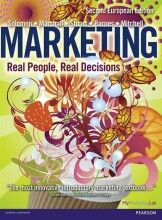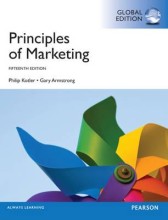Creating the product
17 important questions on Creating the product
How can you classify consumer products:
- By how consumers buy them (Convenience, shipping, specialty and unsought)
What are confidence products?
(examples: Staples( milk, bread, gas) Impulse products and emergency products (umbrella))
What are speciality products?
They have unique characteristics
Consumers insist upon a particular item and will not accept substitutes.
- Higher grades + faster learning
- Never study anything twice
- 100% sure, 100% understanding
What are unsought products?
These require a good deal of advertising or personal selling to interest people.
(needs a lot of advertising)
What are the 3 layers of the product?
- actual product (features, package, brand, quality, appearance)
- augmented product (Warranty, installation, customer support services, delivery, product-use instruction)
Examples for a car:
Core: Transportation, carrying cargo, excitement, image enhancement.
Actual product: Engine size, color, size, style, options available.
Augmented product: 4-year bumper-to-bumper warranty, dealer parts and repair department, free phone customer complaint
What is the innovation continuum? (types of innovation)
Dynamically continuous: a pronounced modification to an existing product, consumers need to learn a bit on how to use it.
Discontinuous: A major change in the way we live. Great amount of learning since they never used a product like it before. (car, plane, PC)
What is idea generation? and what are sources for new ideas?
Sources of new ideas:
- customers
- Sales people
- Service providers
- Anyone with direct customer contact
What happens in the product concept development step?
- Describe features the product should have and benefits those features will provide
- Evaluate the chance for success.
What happens in the marketing strategy development?
- indemnify the target market
- estimate its size
- determine how the product can be positioned
- plan pricing, distribution and promotion.
What happens in the business analysis?
- Evaluate whether the product can be a profitable
- How much potential demand is there for the product?
What happens in the technical development?
- develop one or moer prototypes
- evaluate prototypes with prospective customers
- if applicable, apply for a patent
What is the adoption process?
What defines early adopters?
- heavy media users
- Members include opinion leaders (apple Iphone appeals to early adopters)
What defines early majority?
- deliberate and cautious
- spend more time in the innovation decision process.
What defines the late majority?
- older, more conservative
- Peers are the primary source of new ideas
- Below average in education, income and social status
- wait to purchase unit product has become a necessity and/or peer pressure to adopt.
LOOK AT SLIDES AT HOME FROM 5 FACTORS
What are the 6 stages of consumer adoption of a product?
- Interest : May use teaser advertising
- Evaluation: Providing information on how the product can benefit them
- Trial: Demonstrations, stamples.
- Adoption: Making the product available.
- Confirmation: Reinforcing the customer's choice through advertising ,sales promotion and other communications.
The question on the page originate from the summary of the following study material:
- A unique study and practice tool
- Never study anything twice again
- Get the grades you hope for
- 100% sure, 100% understanding
































